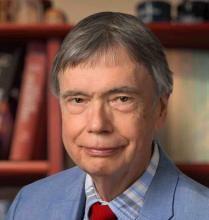
In 2023, Professor Gary Ferland, already a Fellow of the American Astronomical Society, was named a Fellow of the American Association for the Advancement of Science, the first member of our faculty to receive this honor. AAAS cited his development of the synthesis code “Cloudy”, which is used to simulate spectra of astronomical objects. Gary wrote the following overview of astronomy at UK and the role of Cloudy.
The astronomy group has long been noted for its strong theoretical side. Moshe Elitzur, recently retired, was an accomplished particle theorist before moving over to astronomy. His work on interstellar masers has long been well respected. Isaac Shlosman is a dynamicist who has made significant contributions to galactic structure and Active Galactic nuclei. I have been developing numerical simulations of non-equilibrium astronomical plasmas and their spectra.
Observational astronomy has long faced a significant challenge here at UK. We don’t have major astronomical facilities or a big telescope. For the longest time, Tom Troland was the only dedicated observer. His work using ground-based radio telescopes like Arecibo, Greenbank, and the VLA is widely recognized as pioneering in understanding the role of the magnetic field in the interstellar medium. Or, as Tom likes to say, “never neglect the magnetic field”. Ron Wilhelm has used SLOAN database spectra to determine the properties of the pulsating variable stars that help establish the extragalactic distance scale. Renbin Yan, who recently left UK to return to China, also worked with SLOAN. His most recent graduate student, Xihan Ji, has accepted a postdoc at Cambridge University. Gary has worked with a number of orbiting observatories including the International Ultraviolet Explorer, the Hubble Space Telescope, and now the James Webb Space Telescope.
Yuanyuan Su joined our faculty several years ago. She uses NASA’s orbiting X-ray observatories like Chandra and XMM to investigate clusters of galaxies, the largest and most massive structures in the Universe. She came to us from the Harvard Center for Astrophysics where her work with Chandra was especially recognized. She’s done extremely well here in Lexington with one of her very first graduate students, Arnab Sarkar, moving to a post doc at MIT.
This year the astronomy group has added another observer with Ryan Sanders joining us from the University of California. He arrived in the summer of 2023 and has used the James Webb Space Telescope along with other observatories. A future issue of our newsletter will give more details about Ryan and his work.
My work on the plasma spectral simulation code Cloudy was noted in both my AAS and AAAS Fellowship awards. Astronomy is an observational rather than experimental science. We can’t do an experiment; we can only observe. The best way to obtain quantitative information about the Universe is through spectroscopy. This is a grand challenge problem because the plasma producing the light we observe is not in thermodynamic equilibrium.
A Cloudy simulation is built on a foundation of atomic and molecular data. It starts with cross-sections that can be measured in the laboratory and builds a very large system of equations that simultaneously describe all the microphysics that occurs in the plasma. The result is a prediction of the chemical state and spectrum of the gas. We can know whether hydrogen will be a molecule, water, ice, or ionized. We can predict how many electrons are in each energy level. We can predict the spectrum. The intensities of thousands of spectral lines will be predicted in a typical simulation. We then compare this with the spectrum measured at the telescope. Cloudy is now one of the more widely used theory codes in astrophysics.
Work on Cloudy began some forty years ago. Its development continues today as the atomic data improve and computers become more powerful. Seventeen UK graduate student Ph.D.s were awarded for work improving the physics in the simulations and applying them to observational questions. My most recent Ph.D. student, Priyanka Chakraborty, worked on both Cloudy and Yuanyuan Su’s X-ray observations and moved on to a postdoc at Harvard’s Center for Astrophysics.
